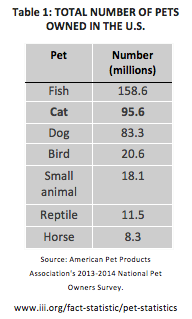Anger
Social Conflict Between Household Cats
Multi-cat households can be twice the fun but have twice the conflict.
Posted December 7, 2015

By: Debra F. Horwitz, DVM, DACVB, Veterinary Behavior Consultations
In many parts of the world companion cats now outnumber dogs as the most popular household pet. In the US there are fewer cat owning households, yet owned cats exceeds owned dogs implying that many cats live with at least one other cat or more (Tables 1 and 2). Due to the innate social ecology of the domestic cat, this can often lead to social conflict between cats and other unwanted behaviors. According to a survey (1), 60% of multiple cat owners (N=240) have experienced tension between their cats within the last 12 months.


In a free living situation cats will aggregate around abundant food resources and within those groups pick individuals that they associate with and those that they avoid. Domestic cats today are very much like wild cats although some are more social to humans and tolerant of living in close proximity to other cats. Unfortunately when brought indoors into the human household, although food is abundant, we usually pick their companions perhaps creating an uncomfortable social situation for certain cats.
Studies have shown that conflict between cats at introduction of a new cat is more likely to lead to ongoing problems (4). Additional studies have shown a correlation with aggressive interactions between household cats and urine spraying (5). An association between housing and stressful events has also been associated with FIC (6).
Naturally in any situation that causes a change in behavior, a good medical examination is needed to rule out and/or treat any medical problems that may be contributory. Chronic pain (dental, arthritic) can lead to irritability, chronic stress can lead to FLUTD and the continuing ongoing stimulation of the HPA axis may cause other physiological changes.
Owners are usually able to notice obvious signs of social conflict; chasing, stalking, growling, hissing, and outright fighting. Unfortunately many of the signs of feline social conflict are subtle and go unnoticed by owners. These include staring, blocking access to locations, anorexia, hiding, trembling, and avoidance. These changes result in a welfare issue as targeted cats are unable to get to important resources: litter boxes, food, and water. These cats are deprived of social interactions with people, opportunities to play and choice lounging areas including window perches or owners laps. Ancillary behavior issues can also arise; house-soiling due to lack of litter box access, ongoing conflicts may stimulate one or more cats to mark with urine and/or claws in the home. It is likely that the entire feline household is affected by social conflicts, not just the obviously anxious and frightened cat.
Once a behavioral history is obtained a treatment plan can be devised. There are multiple interventions that can ease social conflict and increase harmony in multiple cat homes. A good place to begin is with environmental changes to allow cats to share the space and resources in a way that diminishes stress and social conflict (Table 3). Pheromones and other products can also be useful
(Table 4).


More severe cases may require separation of the fighting cats and a detailed behavioral modification plan to reintroduce the cats and these are described in other sources (8, 9, 10).
Where fighting is ongoing with injuries and poor welfare are considerations, a visit to a Diplomate of the American College of Veterinary Behaviorists (dacvb.org) or veterinarian who treats behavior cases is advised.
References
- GfK 2014. Unpublished data from Ceva Animal Health
- www.catvets.com/guidelines/practice-guidelines/environmental-needs-guid…
- Burke Inc. 2014. Unpublished data from Ceva Animal Health
- Levine, E., Perry, P., Scarlett, J., & Houpt, K. A. (2005) Intercat aggression in households following the introduction of a new cat. Applied Animal Behaviour Science
- Pryor PA, Hart BL, Bain MJ, Cliff KD, (2001) Causes of urine marking in cats and the effects of environmental management on frequency of marking JAVMA 219:12: 1709-1713.
- Buffington, C. A. T., Westropp, J. L., Chew, D. J., & Bolus, R. R. (2006). Risk factors associated with clinical signs of lower urinary tract disease in indoor-housed cats. Journal of the American Veterinary Medical Association, 228(5), 722-725.
- DePorter T, Lopez A, Olliver E. (2014) Evaluation of the efficacy of a new pheromone product vs. placebo in the management of feline aggression in multi-cat households. Proc ACVB / AVSAB Veterinary Behavior Symposium, Denver
- Landsberg, G, Hunthausen, W, Ackerman, L (2013) “Feline Aggression” Handbook of Behavior Problems of the dog and cat 3rd edition, SaundersElsevier, Philadelphia, pp. 327-343.
- Lindell EM, Erb HN, Houpt KA (1997) Intercat Aggression: retrospective study examining types of aggression, sexes of fighting pairs, and effectiveness of treatment Applied Animal Behaviour Science 55, pp. 153-162.
- Horwitz DF, Neilson, JC (2007) Aggression/Feline: redirected. Blackwell’s Five-minute Veterinary Consult Clinical Companion Canine and Feline Behavior, Blackwell Publishing, pp 148-154.


